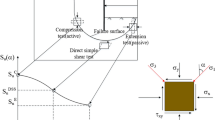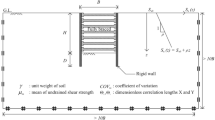Abstract
It is imperative to evaluate factor of safety against basal heave failure in the design of braced deep excavation in soft clay. Based on previously published field monitoring data and finite element analyses of ground settlements of deep excavation in soft clay, an assumed plastic deformation mechanism proposed here gives upper bound solutions for base stability of braced deep excavations. The proposed kinematic mechanism is optimized by the mobile depth (profile wavelength). The method takes into account the influence of strength anisotropy under plane strain conditions, the embedment of the retaining wall, and the locations of the struts. The current method is validated by comparison with published numerical study of braced excavations in Boston blue clay and two other cases of excavation failure in Taipei. The results show that the upper bound solutions obtained from this presented method is more accurate as compared with the conventional methods for basal heave failure analyses.
Similar content being viewed by others
References
Terzaghi K. Theoretical Soil Mechanics. New York: John Wiley and Sons, 1954. 122–130
Bjerrum L, Eide O. Stability of strutted excavations in clay. Geotech, 1956, 6(1): 115–128
Eide O, Aas G, Josang T. Special application of cast-in-place walls for tunnels in soft clay. Proceedings of the 5th European Conference on Soil Mechanics and Foundation Engineering, Madrid, 1972. 485–498
Atkinston J H. Foundation and Slope: An Introduction to Applications of Critical State Soil Mechanics. Berkshire: McGraw-Hill, 1980. 280–305
Architectural Institute of Japan. Recommendations for design of building foundations. Tokyo, 2001. 353–374
China Academy of Building Research. Code for design of building foundation (in Chinese). Beijing, 2012. 176–179
Hsieh P G, Ou C Y, and Liu H T. Basal heave analysis of excavations with consideration of anisotropic undrained strength of clay. Can Geotech J, 2008, 45(6): 788–799
Chang M F. Basal stability analysis of braced cuts in clay. J Geotech Geoenviron Eng, 2000, 126(3): 276–279
Huang M S, Song X Y, Qin H L. Basal stability of braced excavation in K0-consolidated soft clay by upper bound method (in Chinese). Chin J Geotech Eng, 2008, 30(2): 250–255
Liao H J, Su S F. Base stability analysis for excavation in anisotropic clay using slip surface method. Proceedings of International Conference of Urban Ground Engineering. London: Thomas Telford, 1998. 255–267
Chen W F. Limit Analysis and Soil Plasticity. Amsterdam: Elsevier Scientific, 1975. 47–99
Ukritchon B, Whittle A, Sloan S W. Undrained stability of braced excavations in clay. J Geotech Geornviron Eng, 2003, 129(8): 738–755
Osman A S, Bolton M D. Ground movement predictions for braced excavations in undrained clay. J Geotech Geoenviron Eng, 2006, 132(4): 465–477
Lam S Y, Bolton M D. Energy conservation as a principle underlying mobilizable strength design for deep excavations. J Geotech Geoenviron Eng, 2011, 137(11): 1062–1074
O’Rourke T D. Base stability and ground movement prediction for excavations in soft clay. Retaining structures, London: Thomas Telford, 1993. 131–139
Su S F, Liao H J, Lin Y H. Base stability of deep excavation in anisotropic soft clay. J Geotech Geoenviron Eng, 1998, 124(9): 809–819
Wang L Z, Shen K L, Ye S H. Undrained shear strength of K0 consolidated soft soils. Int J Geomech, 2008, 8(2): 105–113
Ou C Y, Hsieh P G. A simplified method for predicting ground settlement profiles induced by excavation in soft clay. Comput Geotech, 2011, 38(8): 987–997
Liu G B, Ng C W W, Wang Z W. Observed performance of a deep multistrutted excavation in Shanghai soft clays. J Geotech Geoenviron Eng, 2005, 131(8): 1004–1013
Hashash Y M, Whittle A J. Ground movement prediction for deep excavations in soft clay. J Geotech Eng, 1996, 122(6): 474–486
Mitchell J K, Soga K. Fundamentals of Soil Behavior. New York: Wiley, 2005. 374–375
Su S F, Liao H J. Effect of strength anisotropy on undrained slope stability in clay. Geotech, 1999, 49(2): 215–230
Prevost J H. Undrained shear tests on clays. J Geotech Eng Div, 1979, 105(1): 49–64
Author information
Authors and Affiliations
Corresponding author
Rights and permissions
About this article
Cite this article
Wang, L., Long, F. Base stability analysis of braced deep excavation in undrained anisotropic clay with upper bound theory. Sci. China Technol. Sci. 57, 1865–1876 (2014). https://doi.org/10.1007/s11431-014-5613-2
Received:
Accepted:
Published:
Issue Date:
DOI: https://doi.org/10.1007/s11431-014-5613-2




